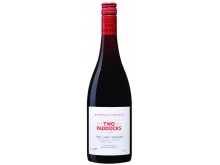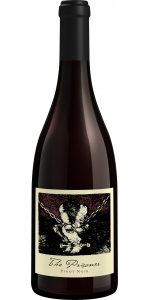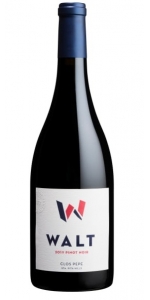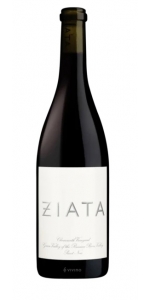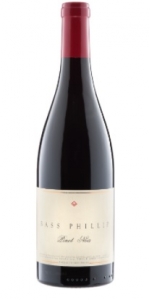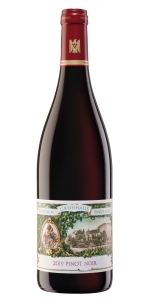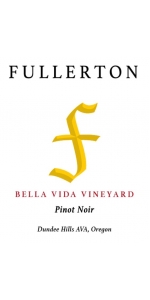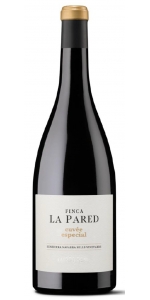Two Paddocks The Last Chance Pinot Noir 2019
| Country: | New Zealand |
| Winery: | Two Paddocks |
| Grape Type: | Pinot Noir |
| Organic: | Yes |
| Vintage: | 2019 |
| Bottle Size: | 750 ml |
The Prisoner Wine Company Sonoma Coast Pinot Noir is made from 100 percent Pinot Noir.
From the most recognized Napa Valley red blend comes a bold, new wine. Made in the same iconic style as The Prisoner Red Blend, we proudly introduce The Prisoner Pinot Noir. Redefining taste once again.
A mix of Russian River and Carneros AVAs produces this classic Sonoma Coast Pinot Noir with notes of ripe cranberry, pomegranate, and cherry with clove spice. The palate is driven by rhubarb and cherry with an underlying minerality and spice, which culminates with soft tannins and an elegant, balanced acidity.
Chef Brett recommends pairing The Prisoner Pinot Noir with Mushroom Risotto or Grilled Salmon.
Walt Clos Pepe Pinot Noir is made from 100 percent Pinot Noir.
Deep ruby in color, the wine carries luscious fruit aromas of blackberry preserves and dark cherry, infused with exotic notes of spice, black tea and pomegranate. The palate opens to a dense and velvety texture laced with flavors of barrel char and salinity, leading to a structured and focused finish.
Review:
Big and rich, with luscious spiciness to the plush dark fruit and berry flavors that are supported by medium-grained tannins. There's plenty of creamy and toasty accents on the open-textured finish.
-Wine Spectator 93 Points
Another Sta. Hills release, the 2019 Pinot Noir Clos Pepe Vineyard saw 10% stems and 10 months in 40% new French oak. It's a little more focused and firm, with classic ripe black raspberry, red plum, and cherry fruits as well as orange blossom, spice, and floral nuances. It too is medium-bodied, textured, and beautifully balanced.
-Jeb Dunnuck 93 Points
- The Clos Pepe Vineyard was founded in the late 1980s by Steven and Kathy Pepe. The vineyard is located just east of Lompoc in the Santa Rita Hills appellation. The 2019 ‘Clos Pepe’ revels in its aromatic range from peat moss and pipe tobacco to bright red fruits and wild blackberry. The palate is dense and fresh with beautiful red florals alongside orange rind with sandy soil undertones. Gorgeous now, this has a long way to go in the cellar.
-Owen Bargreen 95 Points
Ziata Pinot Noir Russian River Valley is made from 100% Pinot Noir.
Vineyard Notes
Green Valley is tightly delineated geographically and climatically, and is the most consistent Sonoma Coast appellation in terms of soil, climate and flavor profile. Two factors, in particular, make it ideal for Pinot Noir. First, the predominant soil type is Goldridge, which with its excellent drainage and low fertility, curtails the vine’s vigor. This results in fewer clusters but of better quality. Second, its elevation and cool coastal climate mean a smaller swing between and day and night temperatures, and its overall cooler daytime temperatures allow for a longer growing season to bring out the full potential of the fruit.
Tasting Notes
This silky Pinot Noir opens with aromas of fresh strawberry, cherry, raspberry and plum, warmed by notes of spice, forest floor and cedar. The wine is fresh and balanced on the palate, with fruit and beautifully integrated oak flowing into a long, juicy finish.
Production Notes
This was the third year of drought, but well-timed watering in the vineyard ensured ample growth and cluster development. Rolling heat spells prior to harvest were kept in check by cool nights, courtesy of the nearby Pacific Ocean. This diurnal range resulted in a medium-bodied, juicy gem of a Pinot Noir.
Bass Phillips Estate Pinot Noir is made from 100 percent Pinot Noir.
For this reviewer's money, BP's Estate Pinot offers the best bang for buck. While still a special occasion wine, it's almost as gorgeous as its elder siblings, and crafted for drinking younger. Ironically, it's also the one that takes longest to open up. But when it does, it billows aromas of dried cranberry, cherry preserves, umami-like mushrooms, cocktail bitters and potpourri. The palate is silky with a lift of crystalline acidity, wound ultra fine, talc-like tannins. An iron fist in a velvet glove, this is long and elegant, able to age another 5-7 years but drinking beautifully right now.
-Wine Enthusiast 95 Points
Carl von Schubert Maximin Grunhaus Pinot Noir is made from 100 percent Pinot Noir.
A concentrated yet elegantly refined Pinot Noir grown in the blue slate soils of the Grosse Lage (grand cru) Abtsberg vineyard.
Review:
Fullerton Three Otters Pinot Noir is made from 100% Pinot Noir - 40 years old
11 months in 25% new Oak and 75% neutral
Bella Vida Vineyard is perched high in the heart of the Dundee Hills. This picturesque site provides elegant fruit from the storied Jory soils of the AVA. LIVE certified.
Aromas of cherry and raspberry flow into finely-tuned layers of cedar, cocoa, licorice, and baking spices. The palate pulses with energy as the silky tannins and gorgeous mid-palate captivate your senses. A radiant and profound experience.
A co-fermentation of Dijon clones 113, 667, and 777, this wine expresses the volcanic soils of the Dundee Hills elegantly, yet powerfully. Upon arrival, the grapes were immediately de-stemmed into an open-top two-ton fermenter. Following a seven day cold soak, the wine started fermenting slowly at a cool temperature. To manage extraction, we utilized one to two punch-downs and one pump-over per day, with two rack-and-returns at the beginning and middle of fermentation. As fermentation neared the end, the must was heated to achieve a peak temperature of 94° F resulting in optimum extraction, and then we immediately chilled the wine to extend the time on the skins, while switching to one pump-over per day to limit harsh, seed-tannin extraction. After a total of 19 days on the skins, we drained and pressed the wine, keeping the free-run and press fractions separate. This bottling contains only the free run fraction. Following two days of settling, the wine was racked to barrel and aged for 11 months in 25% new French oak and one month in tank prior to being bottled unfined and unfiltered.
Review:
Vivid red. Displays fresh red/dark berry and pungent floral aromas, along with suggestions of cola, mocha and five-spice powder. Appealingly sweet and energetic on the palate, offering intense black raspberry, cherry-cola, spicecake and rose pastille flavors that tighten up slowly on the back half. Fine-grained tannins frame the well-defined finish, which lingers with impressive, red fruit liqueur-driven persistence. (all de-stemmed fruit and 25% new French oak). - Josh Raynolds" - Antonio Galloni's Vinous (June 2019), 93 pts
Two Paddocks The Last Chance Pinot Noir is made from 100 percent Pinot Noir.
Spice, wild thyme and Cuban coffee bean aromatics give way to gorgeous fully textured mouthfeel showing great tension and drive. The palate is elegant and flavoursome with a long lingering mineral finish showing poise, memory and site.
Review:
This parcel from Earnscleugh is always elegant and fragrant and has performed well in 2020. There are light red florals of roses, some violets, wild red cherries, raspberries and a fine, spicy layer, as well as sappy elements. The palate has finely layered tannins that anchor in a central red-cherry core of flavor nicely. Fresh, elegant and drinkable, the flavors accumulate in impressive form, really moreish. Fresh acidity, too. From organically grown grapes. Drink or hold.
-James Suckling 96 Points
We started in 1993 with modest ambitions and first planted five acres of pinot noir at our original little vineyard at Gibbston, Central Otago in the deep south of New Zealand.
At the same time, our friend Roger Donaldson planted the land next door, hence the name Two Paddocks. (Roger's paddock proved to be a slow starter, which meant we had to go it on our own; however we kept the title. His brand, Sleeping Dogs, takes its name from the first film we made together.)
I wanted to produce a good pinot noir that would, at the very least, be enjoyed by my family and friends. Frankly, my friends will pretty much drink anything, so this didn't seem too hard. To our great surprise, our first vintage in 1997 was much better than we hoped, in spite of a difficult growing season. 1998 was a more distinguished vintage, and in 1999 we were astounded to produce a pinot that was, we thought, world class. Here was a wine of considerable complexity with an amazing nose, delicious fruit and a good lengthy finish (from clones 10/5 and 5). So rewarding has this vineyard been over the years (and so unpromising as a sheep paddock) that we planted another 5 acres of Burgundian clones there in 2008 bringing the total acreage at The First Paddock, Gibbston, to 5 hectares.
Since that original release in 1997, with each successive year we have produced a pinot noir (sometimes 4 or 5 pinot noirs) that have done us proud and are, to be frank, too good to be wasted on our friends. They still somehow manage to bludge a lot off us, and that, combined with The Proprietor's generous thirst, accounts for the occasional scarcity of Two Paddocks Pinot.
In short, we have become outrageously ambitious - we want to produce year after year, the world's best pinot noir.
Our original vineyard has now been augmented by three other small vineyards, superbly sited in the Alexandra and Bannockburn districts of Central Otago.
The Last Chance vineyard is 7-acres in size on a very beautiful terrace above the Earnscleugh Valley, and sits under some very striking rocky headlands. We planted it with Burgundian pinot vines (5,6,115) in 1998. Two Paddocks "The Last Chance" Pinot Noir is from this single vineyard (first vintage 2002). "The Last Chance" name comes from an old gold miners watercourse that runs through the yard, dating from the 1860s.
In 2000 we acquired Red Bank, a lovely 130 acre small farm nestled between two dramatic rock escarpments. It has become our main vineyard, as we call it rather grandly 'Headquarters', since we have our offices, staff quarters and a splendid Club House as well there. We have planted more Burgundian pinot clones (777,667 and 115 primarily), and the pinot from this, our biggest vineyard, usually forms the backbone of our premium "Two Paddocks Pinot Noir", a wine to die for year after year. (NOTE: Management prefer you not to die for our wine, as we enjoy your custom year after year). We also grow our Riesling here.
Red Bank is, incidentally, more than a vineyard however. It was some years ago, a research station for Crop & Food and we maintain, to this day, many of the medicinal and culinary herbs that were planted then (including lavender, saffron, Echinacea as well as apricots, cherries, apples, pears, truffles etc).
In January 2014, we acquired our fourth small vineyard block, this one in Bannockburn. This a beautifully positioned vineyard, that has been tended with immense dedication and attention to detail and we could not be more delighted to include this iconic site into the Two Paddocks fold. Situated at the end of Felton Road, it is a 6-hectare block entirely devoted to pinot noir and was established in 1999 by Denny Downie and Jane Gill. It lies at the foot of Mount Difficulty and its neighbours are Felton Road, Terra Sancta and Akarua vineyards.
This puts us in the unique position of being the only Central Otago winery with a footprint in all three of Central Otagos great valleys, by owning vineyards in Gibbston, the Alexandra Basin and now the Cromwell Basin. We believe it demonstrates our faith and confidence in the future of New Zealand wine, Central Otago and in particular, Central Otago Pinot Noir.
Finca La Pared Cuvee Especial is made from Graciano & Syrah.
The Cuvee Especial is a Graciano and Syrah blend aged in oak barrels that produces a full-bodied, fresh wine of great complexity and long lasting finish.
Review:
"A deep, brooding nose with lots of fine oak spices and hazelnuts that adorn the blackberries and violets. Succulent and bright on the palate, with caressing, silky tannins dialing into the black and blue fruit. Quite long and subtle. Delicious now, but can hold, too."
- James Suckling (June 2022), 94 pts
- back
Perchaud Chablis Premier Cru Fourneaux is made from 100 percent Chardonnay.
This is the south facing portion of the slope and very hot, heavy "Fourneaux" or "oven" effect.
The wine is expressive and vivacious with beautiful aromas.
Well-balanced, round and fruity wine with a fine minerality on the finish.
1er Cru Fourneaux is located on the Fleys village and faces the field. the plots are very steep and exposed full south on soil type Kimmeridgian consists of marl clay-limestone with shallow ground and a very stony ground. After a slight settling, the juice starts its fermentation in tank, then ¼ of juice is racked in barrels. Both wines perform their alcoholic fermentation and malolactic and their aging on the lees, separately. The two cuvées are blended six months after harvesting. The wine is then filtered and is bottled 15 months after harvesting. 2013 Conditions and Harvest The relatively high temperatures at the end of winter allowed an early bud vines in early March. With a hot, dry spring flower took place in good conditions. In July, a hailstorm located did some damage to our Fourchaume plot. July and early August, rainy and stormy brought the water needed by the vineyards. The dry and sunny weather of the second half of August brought the grapes to maturity. The harvest began on September 2 under cloudy skies.
Coquille St. Jacques (scallops) with leeks and cream.
Proidl Senftenberg Riesling Alte Reben Kremstal DAC is a white wine made of 100% riesling.
Pale yellow green with silver glints. Fine herbal savoriness with white peach and mineral nuances, followed by hints of lime but still rather restrained.
Complex and taut, green apple, fresh acidity, citrus-mineral reverberations and exhibiting length. Definite ageing potential.
Review:
"A pale chartreuse yellow, with a silver sheen. Subtle floral notes, a hint of lime and white stone fruit, apricot and blossom honey. Juicy, elegant, white peach, a refined acidity, mineral and taut on the finish, precise, good length, with ageing potential. - Peter MOSER"
- Falstaff (April 18th 2025), 93 pts

